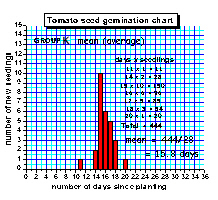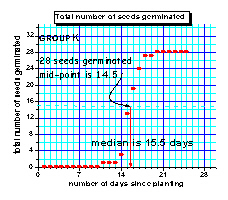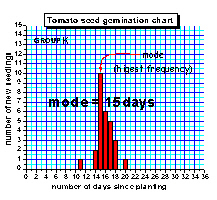The Mean
(average) germination rate
For each day multiply the number of that day by the number of
seeds that germinated on that day. For example, if 4 seeds germinated on the
13th day then calculate the product 4 x 13 = 52.
Repeat this for every day of the experiment. The result will be zero for
the first week or so, and zero again towards the end of the experiment since
no new seedlings will appear.
Add up all the non-zero results.
Divide this total by the total number of seeds germinated. The result is
the average germination rate.
The Median
germination rate
Determine the total number of seeds that germinated in each group. For each
group find the date when the seed in exactly the centre of that
number had germinated.
For example, suppose 21 seeds have germinated in a particular group. Then
the day on which the 11th seed (mid-point of 21) germinated
is the median germination rate for that group.
If the total number of seeds germinated is an even number, for example 16,
then choose the day which is mid-point between 8 and 9 (half days are
permitted).
The Mode
of the germination rate
This is the day (number) or days on which the most seeds
germinated. Several modes are permitted if several days all have an equal (and
maximum) number of new seeds germinated.



